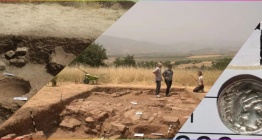Study of Belize Archaeological Project shows ancient Mayas had greater environmental impacts than previously believed
Geographical research conducted by University researchers in Belize found that the ancient Mayan civilization had a greater environmental impact than previously believed.
The Maya were likely responding to environmental hardships, including harsh droughts, when they created expansive wetlands for farming, according to the study.
Timothy Beach, author of the study and leader of the Soils and Geoarchaeology Lab, said the research began in the early 1990s as part of the Programme for Belize Archaeological Project. He said at that time, a multidisciplinary team discovered there was significantly more ancient Mayan settlement in Belize, including canals and wetland fields, than they had previously believed.
“We did 15 to 20 years of slogging through trails doing excavations,” Beach said. “And through that work, we developed a hypothesis that perhaps there’s a lot more of these wetland canals and fields.”
In 2016, Beach said researchers were able to shoot laser pulses through a dense forest canopy and produced a high-resolution recording of the forest floor. He said this technology revealed more of the canal features and the canal system surrounding the fields.
Sheryl Luzzadder-Beach, co-author of the study and professor in the Department of Geography and the Environment, said the more that is discovered about ancient farming, the more that can be understood about the greenhouse gases they produced in the past. She said in addition to the human impact, the research also tells a story about human innovation.
“The ancient Maya adapted fields that had been previously dry-farmed ... and built an incredible infrastructure to continue farming,” Luzzadder-Beach said.
The clearing and enlarging of the fields may have come at an environmental cost by increasing atmospheric carbon dioxide and methane from land-clearing burning events and farming, a problem that has implications toward the volume of greenhouse gas emissions around the world today, according to a press release from the College of Liberal Arts.
Fred Valdez, co-author of the study and anthropology professor, said looking at the Maya from thousands of years ago helps us understand how humans adapt to a changing environment.
“The general trend worldwide, through all of human history, is that humans are very slow to pay attention to the warning signs and we usually react too late,” Valdez said. “All of those indicators have a lot of valuable information that applies to us today. The catch in that is whether people will pay attention to it.”
Image Credit: Barbra Daly / Daily Texan
Source: Avery Wohleb - The Daily Texan [October 17, 2019]








 Marmaris'te kaçak kazı yaparken yakalanan 6 defineciden 5'i tutuklandı
Marmaris'te kaçak kazı yaparken yakalanan 6 defineciden 5'i tutuklandı  Büyük İskender'in ninesinin doğduğu Lyncus Antik Kentinin bulduğu iddia edildi
Büyük İskender'in ninesinin doğduğu Lyncus Antik Kentinin bulduğu iddia edildi  Sülale boyu arkeolojiye emek veren ünlü arkeolog aileleri
Sülale boyu arkeolojiye emek veren ünlü arkeolog aileleri  Bilim tarihçisi Prof. Dr. Emre Dölen vefat etti
Bilim tarihçisi Prof. Dr. Emre Dölen vefat etti 




